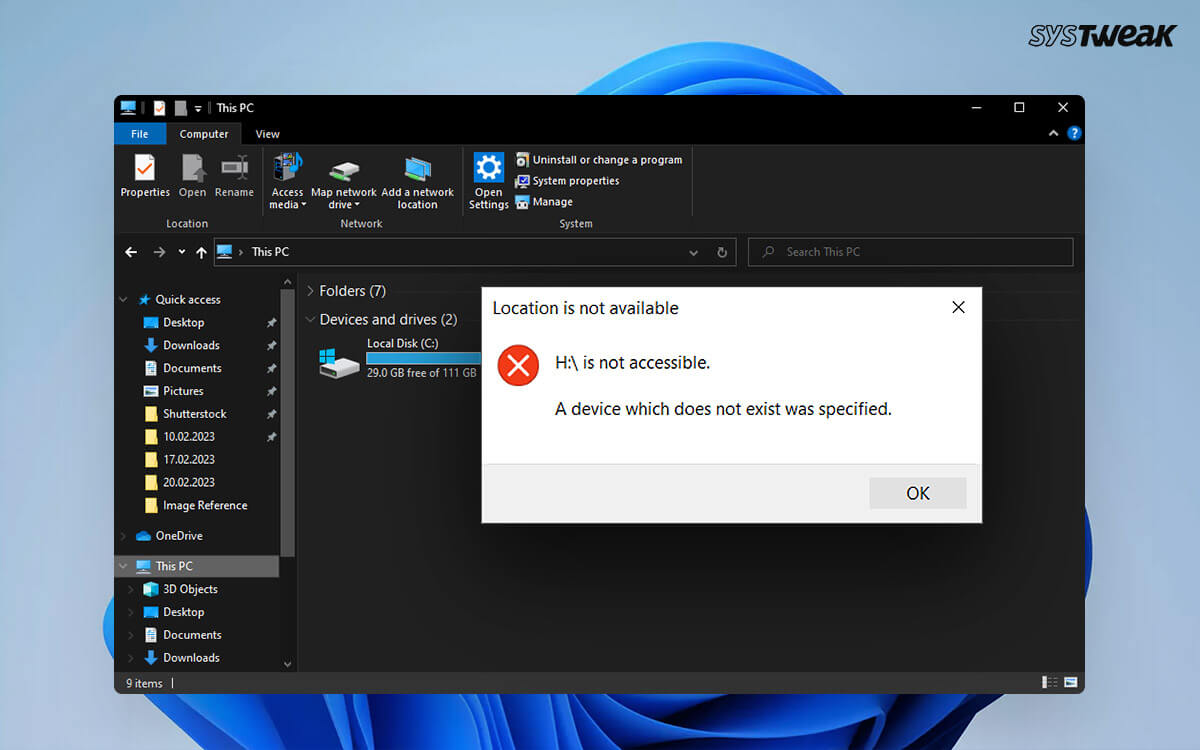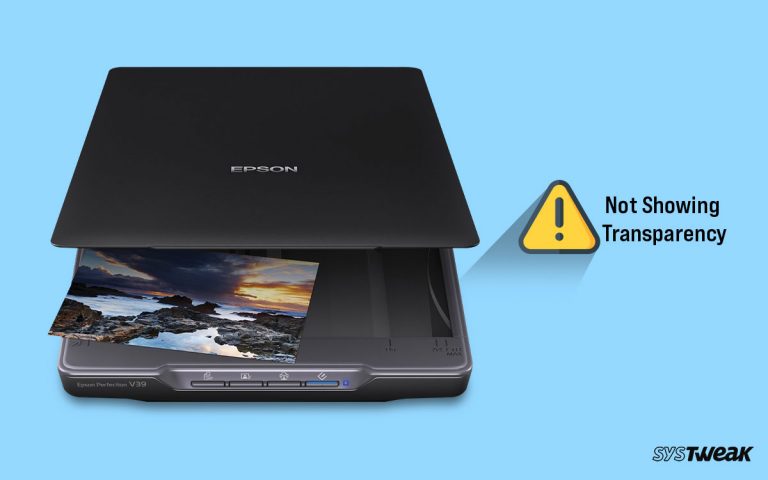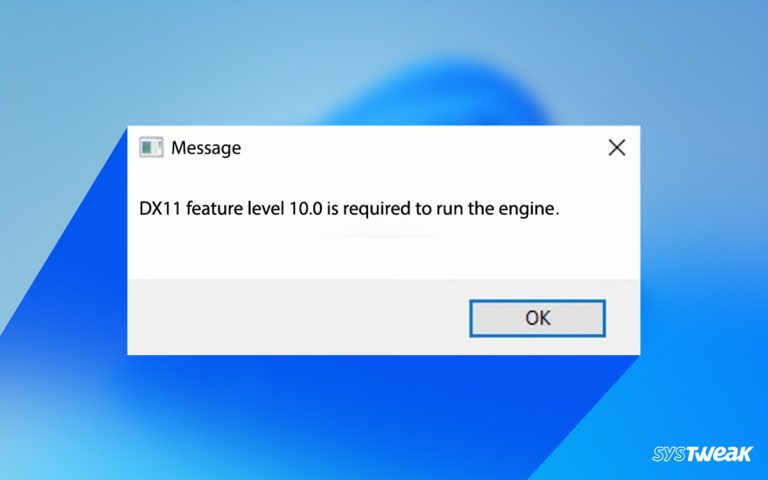Have you encountered the “A device which does not exist was specified” error while connecting an external device? It is a common error, and there’s nothing to worry about as it can be fixed.
50% OFF

BLACK FRIDAY OFFERS
Unlock Black Friday Mega Savings — Systweak Tools FLAT 50% OFF!
The “A device which does not exist was specified” error occurs while accessing a hard drive, SSD, or USB drive connected through a damaged port. The issues have many layers and pose a real problem for multiple users. Staying aware of the fixes is important. This blog will look at two factors related to the problem.
We will first address the causes and later look at some of the fixes you can implement to overcome the error.
What Causes the “A device which does not exist was specified” Error?
The error “A device which does not exist was specified” corresponds to connecting external devices, directing you toward connectivity-related errors. Multiple factors cause this particular problem. Some factors are listed below –
- Loose Connection of Drive
- Defective USB Ports
- Issues With Permission to Access
- Driver Issues With Motherboard & Connectivity
Other than these issues, you can never rule out the possibility of hardware-based errors that may occur in the driver itself. If you have seen the prompt for “A device which does not exist was specified,” you might notice that the drive letter is often missing. It is because of the partition error, and it requires you to reset your Windows.
So, how do you overcome these issues? A few fixes can help resolve the “A device that does not exist was specified” error. Check them out in the next section!
Ways to Fix “A device which does not exist was specified” Error Quickly!
Knowing the possible issues that might have triggered the error, you can now move on to implementing the fixes.
Fix #1 – Check for Physical Discrepancies
While connecting a USB drive to your computer, establish the connection properly. To be sure that the “A device which does not exist was specified” error is not caused due to a physical connectivity issue, make sure that you –
- Check the connection stability of the port by using a different drive you have used previously.
- Try changing the port for the drive that has shown the error. It is possible that the port is damaged and not the drive.
- If you are doubtful of the USB driver or SSD you are trying to connect, try plugging it into a different drive to confirm it is working.
- Make sure that you are using a supported port. For instance, connecting a USB 3.0 or 3.1 drive to an older port might cause the issue.
These checks help specify the possible issues you may encounter while dealing with the errors. If something comes across as problematic in your checks, fix that immediately.
Fix #2 – Uninstall & Reinstall Internal Hard Drive
If the issue lies in the internal hard drive of your PC, instantly uninstall the device and restart your PC. It will trigger the motherboard to treat the drive as new and reinstall the driver for you with the correct partition name. To uninstall the device –
- Open the Device Manager on your PC. You can use the Start menu to search for the same or the Run window by pressing Windows +R with the command devmgmt.msc

- This will take you to the Device Manager. There you can find your disk drive option.
- Simply expand it to find your device. Right-click on it and click on uninstall to remove the device from your PC.

- As soon as it is uninstalled, restart your computer.
This will give your motherboard time to re-analyze and install the connected drive. If you cannot see the drive again, you need to disconnect and reconnect the drive physically.
Fix #3 – Fetch Proper Permission for Accessing the Drive
Sometimes, the location is not available (“A device which does not exist was specified”) error appears when you do not have access permissions. To gain the permissions, all you have to do is –
- Open File Explorer and Select the Drive that Keeps Showing the Error.
- Right-Click on the Selected Drive and Open Properties.
- In Properties, Look for Security Tab and then Click on Edit.

- In Edits, You can Find a Category Named “Permissions for XXXX (your current logged-in account).”

- In the Permissions, Select ‘Full Control’
Save the changes that you have made. Close the File Explorer and refresh your desktop. Try reaccessing the drive; the error “A device which does not exist was specified” must be gone.
If this does not work, move to the next fix!
Fix #4 – Check Your Motherboard & USB Drivers
Drivers are the fundamental components that allow communication between an external device and your PC. The external connectivity lies with the USB drivers, while internal connectivity depends on motherboard support and drivers.
If drivers are damaged or outdated, it can cause the “A device which does not exist was specified” error.
However, keeping track of these drivers is nothing less than a headache. There is no inbuilt prompt for the outdated drivers in Windows. That means the user learns about it when there is an error.
Not to mention, manually updating your drivers is a daunting process which is why you find driver updates in the market. One such tool that I use and have used to resolve the “A device which does not exist was specified” error easily is the Advanced Driver Updater.
Here’s how you, too, can use the tool –
- Download the installer for Advanced Driver Updater from the link below.
- Launch the application and instantly find the Start Scan Now option.

- Click on it to initiate the process. It means the tool’s hunt for outdated drivers begins!

- When the scan is finished, you get a list of outdated drivers. Some might be unknown to you. Do not worry, as these are probably system drivers or motherboard drivers.

- Simply click on update all to stay ahead of every issue that outdated drivers might cause in the future.
It is that easy. As soon as the tool finishes the update process, you can retry to open the affected drive, only this time, the error “A device which does not exist was specified” will not be there!
“A Device Which Does Not Exist Was Specified” Error Is Resolved!
You can easily overcome the error using the above fixes and a little presence of mind. The solutions shared above have been tried and tested, so you do not have to worry about them.
If the issue is with an internal hard drive or the alphabet of your internal hard drive address has changed, resetting the PC is the best option.
We have reached the end of this post. I hope you find these fixes helpful. Let me know which fixes worked best for you in the comments section. Good luck!
Next Read : How to Fix “MTP USB Device Driver Failed” Problem for Windows 11, 10, 8, 7





